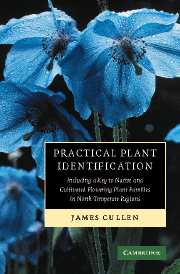 Practical Plant Identification
Practical Plant Identification Book contents
- Frontmatter
- Contents
- List of illustrations
- Preface
- Acknowledgements
- Introduction
- Examining the plant: a brief survey of plant structure and its associated terminology
- Using the keys
- Keys
- ‘Spot’ characters
- Arrangement and description of families
- Further identification and annotated bibliography
- Glossary
- Index
Using the keys
Published online by Cambridge University Press: 02 December 2009
- Frontmatter
- Contents
- List of illustrations
- Preface
- Acknowledgements
- Introduction
- Examining the plant: a brief survey of plant structure and its associated terminology
- Using the keys
- Keys
- ‘Spot’ characters
- Arrangement and description of families
- Further identification and annotated bibliography
- Glossary
- Index
Summary
The keys in this book are of the bracketed type and are dichotomous throughout, i.e. at every stage a choice must be made between two (and only two) contrasting alternatives (leads), which together make up a couplet. To facilitate reference to particular leads, each couplet is numbered and each lead is given a distinguishing letter (a or b). As the main key allows for the identification of over 320 families, it has been arranged into groups, with a key to the groups at the beginning.
To find the family to which a specimen belongs, one starts with the key to groups and compares the specimen with the two leads of the couplet numbered 1. If the specimen agrees with 1a, one proceeds to the lead with the number that is the same as that appearing at the right-hand end of lead 1a (in this case, 2); if, however, the plant agrees with lead 1b, then one proceeds to the couplet numbered 14. This process is repeated for subsequent couplets until, instead of a number at the right-hand end of a lead, a group is reached. Throughout this process, it is very important that the whole of each couplet be carefully read and understood before making a decision as to which lead to follow.
- Type
- Chapter
- Information
- Practical Plant IdentificationIncluding a Key to Native and Cultivated Flowering Plants in North Temperate Regions, pp. 51 - 56Publisher: Cambridge University PressPrint publication year: 2006


